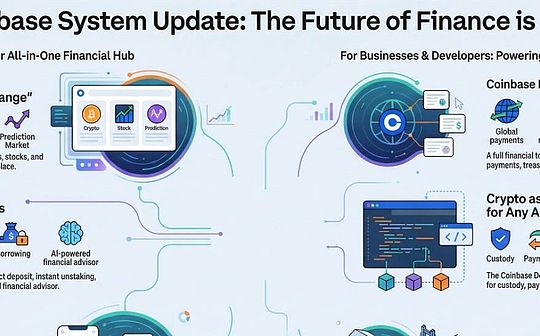
Author: Hyphin, Thor Hartvigsen Source: Onchaintimes Translation: Shan Ouba, Bitchain Vision
Establishing a trading venue is a large -profit cause, which has attracted a lot of opportunistists with strong funds and knowledgeable knowledge. Therefore, the competition is extremely fierce, and exchange operators are desperate to compete for market share.The possibility of becoming the mainstay of trading is very small, but if it is relatively successful, the dividend will far exceed the huge efforts and resources required to engage in such business activities.
introduce
We repeatedly witnessed the exchanges’ efforts to maintain lead.The business behavior of behind -the -scenes transactions and moral or ethical problems is a standard tool for many centralized entities.The lack of transparency caused many illegal acts to be ignored or covered.Coupled with the problem of custody (derived from frequent and blatantly abused customer custody funds), traders began to slowly involve the client after realizing that the regulatory intervention and social media resistance seemed to be a inefficient catalyst.
>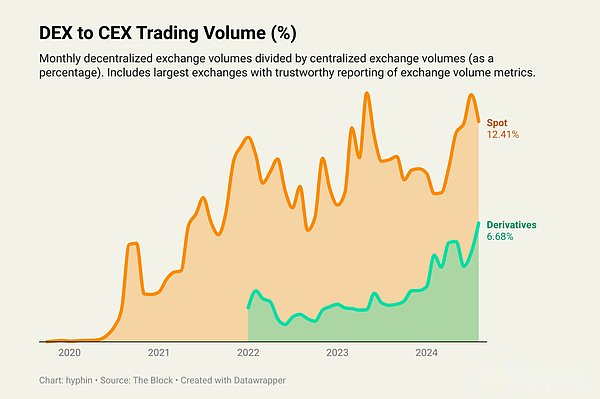
In recent years, with the improvement of the adoption rate, the improvement of infrastructure scalability and the efficient protocol modeling, the use indicators and transaction volume of decentralized exchanges have increased significantly.Although they provide higher visibility, access to strange assets, reducing the risk of transaction opponents, and no need to identify, they still face a series of unique challenges, especially inUser experienceandLiquidityFields.Because most protocols are almost different in terms of function, even the smallest technical advantages will be more obvious, so the solution of congenital defects usually determines the correlation of DEX.Vertex has become a powerful example of this aspect. We will focus on how it successfully overcome these obstacles and stand firm in the marketEssence
Powerful vertex
Vertex has a comprehensive product kit, providing traders with one -stop services, allowing themSpot goodsandpermanentFutures transactionCurrency markettrade.The agreement mainly focuses on derivatives, accounting for about 8%of the top 10 annual transactions of many chain stores in the industry.
Its core is a clever mixed trading mode, which willCentral price limit order book(CLOB) andAutomato(AMM) Integration, it aims to provide lightning -like execution time and optimal liquidity, which can be comparable to the traditional platforms used by professionals and institutions.
To understand the true working principle of this implementation method, let us break down its key components and draw a subtle and complicated contribution to the effect, because they play a key role in the upcoming part.
Obviously, the technology stack is industry -grade and can be verified, but the ultimate large -scale use is driven by traders interacting with Web applications rather than software development tool packages.Regardless of whether or not, most users usually rarely care about the foundation of the product, but take action based on the content and feelings they see.The importance of a cohesive interface cannot be underestimated.Beautiful, easy -to -use, and even tiny quality of life are important, because the proper front -end purpose should be abstracted from all complex logic.Considering these factors, Vertex is introduced by general crossDeposit accountIn terms of user experience, a lot of thoughts have been invested. Among them, the entire investment portfolio of the user is used as a mortgage, which offsets the margin requirements of multiple positions.Unlike the isolation margin that limits the risk to a single position margin, the cross margin allows the liabilities to share the liabilities to a single address, thereby reducing the liquidation risk and reducing the margin requirements.The platform can also be realizedRisk managementAutomation, optimizationCapital efficiencyAnd provide seamless interface to manage the position.This setting has benefited the traders because it does not need to switch between accounts and supports more efficient trading strategies (such as basic transactions).
In addition to transactions, there are various income options.The pledge of the original generation currency to earn part of the transaction fee generated by the agreement, provides liquidity for the capital pool, and uses the currency market supply/borrowing assets or deposited into the ecosystem insurance library.The latter is a new feature, with automated strategies from related projects such as Skate Finance and the upcoming Elixir.
edge
Liquidity fragmentation constitutes a serious problem on the blockchain economy. As the new level enters the market in groups, its impact is increasingly obvious, and these new levels are often accompanied by irresistible incentives.Given that the loyalty of this industry was not returned, a large amount of capital poured into the bridge, which further exacerbated dilution.This actually forced builders to deploy on many chains to broaden their potential markets.Therefore, in the context of the trading venue, the daily transaction volume is scattered, and no network can be used as the leader.
>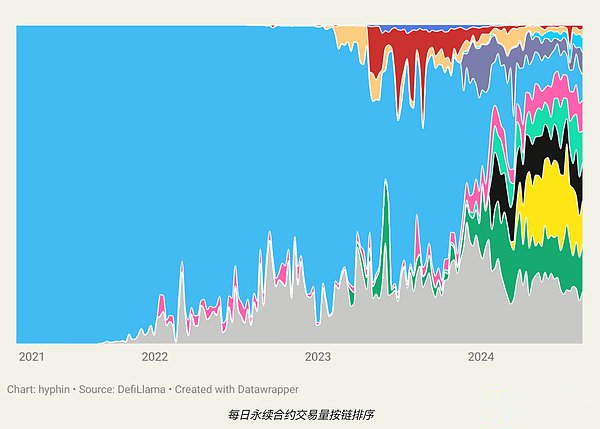
Although Ethereum (L1) was once the main hub of sustainable contracts, it has now been replaced by a large number of high-end Rollup and Layer-1 that is more suitable for these DAPPs.The establishment of synchronization is ideal for visibility, but it is at the cost of low -efficiency single markets. These markets are vulnerable to the impact of volatility and increased point.
To solve this problem, Vertex adopts the method of intertwining the liquidity between all independent instances, rather than integrating it into a single environment (such as custom application chain).This is implemented through EDGE. Edge is a cutting -edge simultaneous order book liquidity product. It aims to unify the cross -chain liquidity between multiple networks, so that no external third -party bridge is required.It enhances the existing trading engine by aggregating liquidity from different chains to a single unified order book managed by sorters.This novel mechanism allows efficient order matching and settlement between multiple blockchain deployments.It will not disperse liquidityOr may give up the ecosystem rewards.
>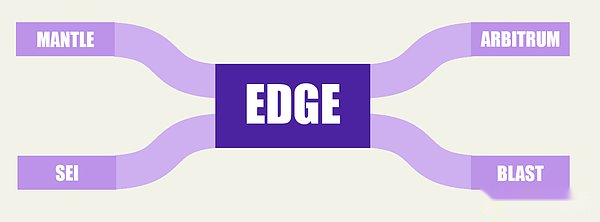
EDGE acts as a virtual city merchant, supports transactions across various chains, while maintaining low latency and high performance of its publicity.By synchronizing liquidity, it canOptimize the market depthAs well asReduce slipAnd provide seamless trading experience, support spot, sustainability and currency market.Improve the demand for block space,Improve the liquidity on the chainAnd reduce the development costs of operators, and jointly make integration of net profit in both users and underlying basic layers.
Attractive
1. Liquidity
Edge uses two different protocols on the four different chains.Specifically, Blitz and Arbitrum, Mantle and SEI on BLAST.Among these four networks, Edge has accumulated a total lock value of more than $ 100 million, of which more than 75% are located on Arbitrum.Through the latest integration of SEI and Mantle, Edge is providing deep permanent liquidity for various ecosystems.
>
>
The liquidity of saving in VerteX is not just idle mortgage for sustainable transactions.Specifically, assets can be added to the AMM liquidity pool, and the liquidity in it can still be used as a available margin for perpetual futures transactions.The deposit deposit can also be borrowed through Vertex’s internal borrowing market.As shown in the cake diagram below, most of the assets that are stored in the Edge protocol (Vertex and Blitz) are WBTC, WETH and stablecoin, USDC, USDB and USDT.
>
Since last year, the Edge market has contributed to more than $ 130 billion in trading volume on the four chains.Users can trade more than 50 different currency pairs across the margin. The leverage of BTC and ETH can reach up to 20 times, and the leverage of cottage can reach up to 10 times.In the past week alone, Vertex Edge’s transaction volume exceeded $ 2 billion, which is one of the largest chain -sustainable futures platforms in the entire cryptocurrency field.
>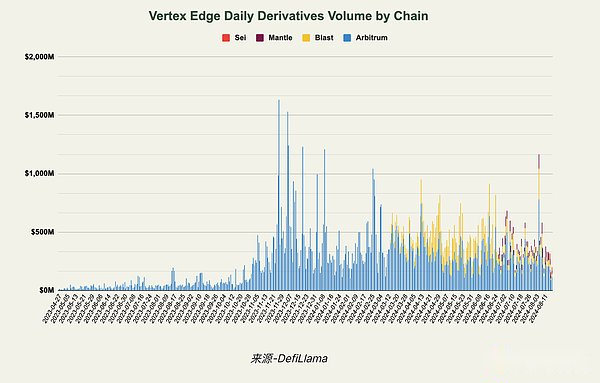
Although more than 80% of historical transactions are generated on Arbitrum, today’s large amount of transaction volume is generated by traders of Blast, Mantle, and SEI.As of August 19, 2024, today’s transaction volume composition:
-
Arbitrum: 58%
-
Blast: 14%
-
Mantle: 13%
-
SEI: 15%
>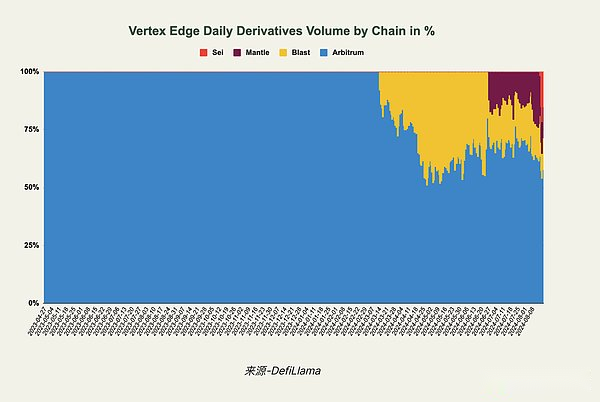
With the launch of SEI, traders on high -performance parallel EVM chains can get a unified order book liquidity.In addition, SEI also distributed a total of 5.1 million SEI (850,000 SEI per week in the next six weeks) to the vertex trader on the SEI blockchain.
3. Cost and income
Like his chain exchange, Vertex will charge fees from traders on the platform.Compared with other DEX, the cost of trading on Vertex is extremely low, which is more similar to trading in centralized venues.The lower limit order in all Vertex Edge markets (orders) is free, while market orders (recipients) charge 2 basis points (0.02%) fees.Vertex charged the cost of different protocol participants.First of all, the cost is used to pay the market business (hung orders) to motivate the deep liquidity of the order book and the AMM and the currency market.The expenses that are not paid to liquidity providers are designated as agreement income, and are directly used for insurance funds, VRTX pledges and for operating expenses.
>
>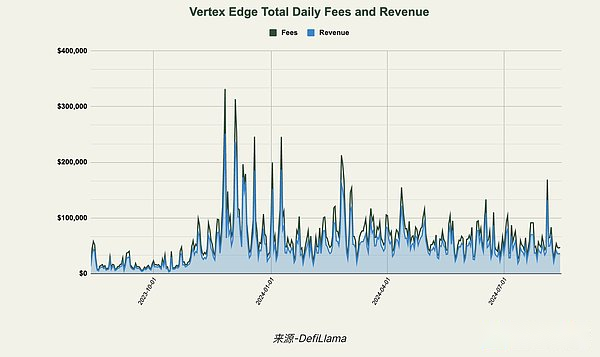
Among the income generated by Vertex, up to 50% per week is assigned to VRTX pledges.By extending VRTX pledge time, the pledge reward obtained by users can increase up to 2.5 times (6 consecutive pledge).The average average reward of VRTX pledges is 33%annualized.The specific income amount assigned to the pledker every week can be found in the Vertex X account.
Finally, some VRTXs were issued to inspire traders, including city merchants and recipients.A total of 44% of VRTX supply is used as a transaction reward.
in conclusion
Vertex uses a hybrid mode that combines high -speed execution with strong liquidity management to occupy a strong position in the field of competitive decentralized exchanges, and also solves the key challenges of user experience and cross -chain liquidity.By integrating innovative functions such as EDGE and providing seamless trading interfaces, the platform not only improves transaction efficiency, but also provides a safer and more user -friendly environment.This method has made Vertex occupy a considerable market share and become a leading platform in the field of DEFI, which proves the importance of technological innovation and user -centric design to success.


